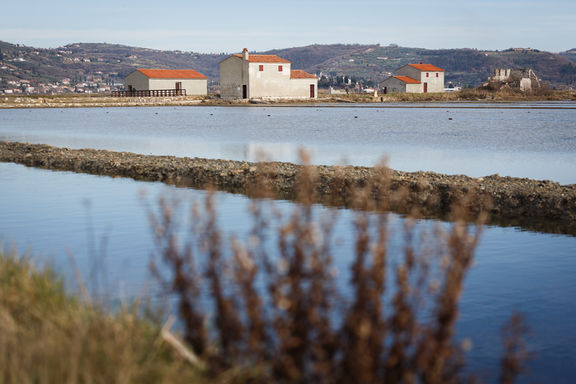Difference between revisions of "Museum of Salt Making, Sečovlje"
Janez Premk (talk | contribs) |
Janez Premk (talk | contribs) m (→Collections) |
||
| Line 34: | Line 34: | ||
== Collections == | == Collections == | ||
| − | Within the Sečovlje regional park one can see the abandoned and the still functioning salt | + | Within the Sečovlje regional park one can see the abandoned and the still functioning salt fields, channels and levees with stone walls, steps and sluice gates (with only their stone parts preserved), paths, bridges, wind pumps, and salt-pan houses, including their ruins and localities. The salt maker’s dwelling is a two-storey house which functioned as both family residence on the first floor and salt store on ground floor. |
| − | The museum is organised within a renovated salt pan house Caserma. The artefacts, photographs and texts which form the collection illustrate the working and living environment of the salt makers. On the ground floor visitors can learn about the development of salt making in the north east Adriatic. Tools used for work in the salt pans and store houses are displayed here, and in nearby restored salt | + | The museum is organised within a renovated salt pan house Caserma. The artefacts, photographs and texts which form the collection illustrate the working and living environment of the salt makers. On the ground floor visitors can learn about the development of salt making in the north east Adriatic. Tools used for work in the salt pans and store houses are displayed here, and in nearby restored salt pans a group of salt workers demonstrate traditional methods. |
In the Lera centre of salt making one can see a film on cultural heritage of Sečovlje, in a multi vision room but can with the modern technology explore the salt pans, flora and fauna, commonly invisible to the mere visitors. | In the Lera centre of salt making one can see a film on cultural heritage of Sečovlje, in a multi vision room but can with the modern technology explore the salt pans, flora and fauna, commonly invisible to the mere visitors. | ||
Revision as of 22:59, 21 February 2010
Background
The oldest saying about Piran tells: Piran xe fato de sal! Piran was made out of salt. Salt making was one of the major economic branches of Piran (beside fishing and craft) which enabled the development of the town. The citizens had two dwellings, in Piran during the winter and in Sečovlje during the summer, when the salt making season began.
The Sečovlje Regional Park covers about 650 ha along the Slovene-Croatian boundary with the active salt making in its northern part, called Lera. The southern part, called Fontanigge, is separated by the bed of the Drnica stream and overgrown by salt-loving vegetation – halophytes. The Fontanigge is knit with large basins, crisscrossed by the system of ancient levees. Along the former salt-pan stone made houses are scattered, which co-create the truly unique image of the salina landscape. The traditional way of salt making, originating from the 14th century, was abandoned in the 1960s, but is still practiced within the Museum of Salt making.
The Sečovlje salt pans are a scene of Genius Loci Lera Workshop, organised annually by Obalne galerije - Coastal Galleries and Soline Pridelava soli d.o.o. within the Ex-tempore Piran - International Painting and Ceramics festival since 2003.
Collections
Within the Sečovlje regional park one can see the abandoned and the still functioning salt fields, channels and levees with stone walls, steps and sluice gates (with only their stone parts preserved), paths, bridges, wind pumps, and salt-pan houses, including their ruins and localities. The salt maker’s dwelling is a two-storey house which functioned as both family residence on the first floor and salt store on ground floor.
The museum is organised within a renovated salt pan house Caserma. The artefacts, photographs and texts which form the collection illustrate the working and living environment of the salt makers. On the ground floor visitors can learn about the development of salt making in the north east Adriatic. Tools used for work in the salt pans and store houses are displayed here, and in nearby restored salt pans a group of salt workers demonstrate traditional methods. In the Lera centre of salt making one can see a film on cultural heritage of Sečovlje, in a multi vision room but can with the modern technology explore the salt pans, flora and fauna, commonly invisible to the mere visitors.
See also
- Sergej Mašera Maritime Museum, Piran
- Genius Loci Lera Workshop
- Tona’s House - St Peter's Ethnological Collection
- Ex-tempore Piran - International Painting and Ceramics



